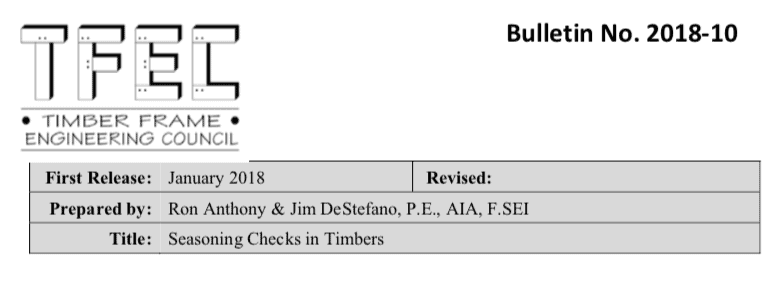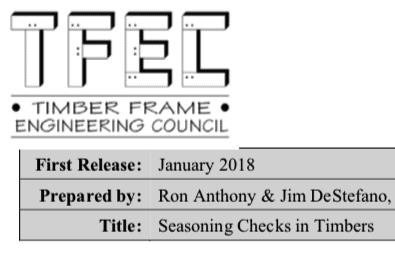
The Timber Frame Engineering Council (TFEC) is an organization within the Timber Framers Guild dedicated to the systematic research, discussion, and codification of timber frame joinery and structural practices. Its members are committed to advancing the technology of timber frame engineering.
To that end, the TFEC produces studies and reports that help advise timber framers and structural engineers as they undertake projects. Wood scientist Ron Anthony and engineer Jim DeStefano collaborated to write a bulletin on “seasoning checks,” which are separations of the wood along the grain that occur as the wood dries. Although they may look dramatic, in some cases as a single, wide, and deep separation, seasoning checks are not defects; in fact, it’s rare to find a timber that does not have checks!
Checks usually form along the grain, but in young wood can appear across wood fibers due to the rapid growth of a young tree. When looking at a timber, you’ll notice that the check is at its widest at the outer surface and becomes narrower as it approaches the heart of the timber. Checks at the ends of timbers form much more rapidly than along the length because the end grain is exposed, and you’ll find that for many projects timber framers will have timbers longer than needed so they can cut the end grain from the timber before installation. By that time the timber will have acclimated to the environmental humidity at the job site.
The cut of a timber can also impact the nature and placement of checks. A plain sawn timber usually shows a single wide check, but a vertical or quarter-sawn timber frequently shows multiple narrow checks due to radial shrinkage.
Mr. Anthony and Mr. DeStefano write that “Shrinkage at the surface of a timber is restrained by the core that has not yet dried, resulting in stresses in the wood that are relieved by the formation of checks.” Frequently people misidentify checks as a fracture or structural failure, but understanding that the timber dries incrementally over time, with the heart being the last thing to dry out and season, should help alleviate any concerns about the structural integrity of a timber – whether it’s been in place for years or is newly placed.
Seasoning checks do not alter the structural performance of a timber because they run along the grain and don’t reduce the timber’s ability to resist axial tension or compression stresses. The checks have an added benefit: since the checks run with the grain of the wood, they help in the evaluation of a timber for strength when doing grading.


